Whether you’re camping in the woods of Southern Maine or enjoying a cozy hearth fire in a rustic cottage Downeast, there’s a lot you should know about Maine Firewood. In this blog, we want to cover the full spectrum of things you should (or might want to) know about Maine Firewood. We will cover what you need to know to have a legal fire in Maine, the best types of firewood to use and how to store and use it effectively, and the history of logging in Maine.
What You Must Know About Maine Firewood: The Legalities
There are various rules around having fires in Maine. If you have a wood stove or a fireplace in your home or cottage, you can have safe fires at any time without the need for any kind of special permits. However, it’s a little more complicated for “open fires” in Maine.
In general, recreational campfires on a property you own and outdoor grills and fireplaces for recreational purposes, such as preparing food are permissible without a permit, as long as no nuisance is created.
A burning permit is required for burning brush piles and wood debris, which may be subject to more restrictions. The Maine Forest Service advises people to call them with any questions, as they would rather answer questions than issue a ticket.
If you’re at a campsite, you may require a campfire permit to have a fire legally.
Campfire Permits
In Maine, campfire permits are not required for small recreational fires on a property you own in organized towns. However, it is recommended to check with local fire officials or the town office to ensure that there are no ordinances in place requiring a permit.
In unorganized towns, the Maine Forest Service issues campfire permits for remote “permit” campsites. These permits can be obtained by contacting the local forest ranger or the Maine Forest Service regional headquarters closest to the unorganized town. Campfire permits are not issued more than two days in advance.
Keeping Maine Campfires Safe
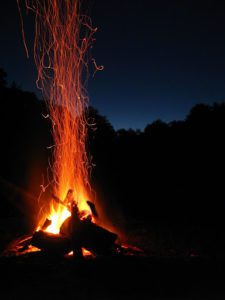
Everyone loves a good campfire, but make sure yours is safe!
To ensure safety when building a campfire in Maine, it is important to check the daily fire danger rating in the area and to keep the fire small and contained. It is recommended to use a fire ring made of non-combustible materials and to clear combustible materials such as sticks and leaves away from the ring’s edge.
It is illegal to burn trash and most manmade materials in a campfire, only wood wastes such as brush, stumps, wood chips, painted and unpainted wood, paper, and cardboard can be burned. It is also important to avoid burning fallen leaves as they can easily ignite and cause a forest fire. You should rake your fire site clear of any leaves to reduce this risk.
You Must Use Maine Firewood In Maine!
Bringing outside firewood into Maine is not only illegal but also a dangerous threat to the forest and its wildlife. The Maine Department of Agriculture, Conservation, and Forestry highly recommends purchasing firewood locally after arriving in the state to reduce the chance of transporting pests and diseases.
One local company that offers a great option for firewood is Day Logging. They offer kiln-dried firewood that has been treated with heat to kill all pests and mold that might be lurking inside the wood, making it a safe and reliable choice for outdoor enthusiasts.
Buying firewood in Maine is essential to the health of the Maine woods. Not only does it help prevent the spread of pests and diseases, but it also supports local businesses and the economy. By choosing to buy locally sourced, heat-treated firewood, you are not only ensuring a safe and enjoyable outdoor experience, but you are also helping to protect the natural resources of the state.
When buying firewood, it is important to look for firewood with a state seal stating the wood has been heat-treated to 160 degrees Fahrenheit for at least 75 minutes to make sure it is pest-free. Additionally, it is recommended that you purchase firewood as close to your destination as possible and burn it within 50 miles of where it was harvested if it hasn’t been heat-treated. At Day Logging, we typically heat-treat both seasoned and kiln-dried firewood.
Purchasing firewood from a local, reputable source like Day Logging is a great way to support the local economy while protecting the health of the Maine woods. By choosing heat-treated and certified firewood, you can ensure that your outdoor experience is safe, enjoyable, and in line with state regulations.
Getting The Most Out Of Your Maine Firewood
A lot goes into buying, drying, and storing firewood in Maine. Here we’ve put together in-depth explanations of best practices for getting the right firewood for your needs, how to store it effectively, and some tips for starting fires safely and under different conditions.
Buying The Right Type Of Firewood
When it comes to firewood in Maine, the best option depends on your use case.
For indoor use, kiln-dried firewood from a local source is especially beneficial thanks to its very low levels of creosote, which can cause chimney fires when it builds up excessively. This type of firewood has been treated with enough heat to kill all pests and mold that might be lurking inside the wood.
Hardwoods, such as oak, hickory, and maple, are generally considered the best types of firewood to burn because they have a higher density and lower sap content compared to softwoods like pine and cedar. Hardwoods are known to produce more heat and burn more efficiently, which means you get more heat from your fires, and less creosote is allowed to develop within your chimney.
For outdoor use, it’s best to purchase firewood that is specific to the area where you’ll be using it (within 50 miles) or has been heat-treated and has a low moisture content. Since kiln-dried wood is generally more expensive, seasoned local firewood is often a better choice. To check if the wood is seasoned, check if it’s grayish in color, the bark should be splitting and separating from the wood, and two logs should make a hollow “thud” when banged together.
Seasoned softwoods are a relatively good option for outdoor burning since creosote is less of a concern. Sometimes softwood firewood can be found at lower prices as it’s generally considered less desirable for indoor use.
By following these guidelines, you can ensure that your firewood burns efficiently and produces the most heat possible when it matters while also supporting the local economy and protecting the state’s forest resources.
In Summary…
- The most important trait of firewood is that it’s dry
- It’s recommended you use firewood within 50 miles of where it was harvested or ensure it’s heat-treated like Day Logging’s seasoned and kiln-dried firewood
- Hardwoods produce less creosote on average and produce more heat, making them ideal for indoor heating
- Softwoods produce less heat and have more sap but are great for outdoor use, such as campfires or cooking fires
Finding Firewood to Buy in Maine
Maine is a beautiful state that is known for its harsh and snowy winters, which is why firewood in Maine is such a valuable commodity. If you’re looking for firewood for sale in Maine, there are many options available to you, from small bundles of firewood sold at supermarkets, gas stations, and convenience stores located near popular camping sites to larger loads of a cord of wood or more available from local firewood producers such as Day Logging.
At Day Logging, we are a family-owned and operated business that takes pride in offering high-quality Southern Maine firewood that is seasoned and ready to burn. Our firewood is processed to ensure that it is of the highest quality, and we are committed to providing our customers with the best product possible. We understand the importance of having reliable firewood during the winter months, which is why we take the time to process our firewood carefully to ensure that it is ready for use.
Buying in Bulk
If you’re looking for larger quantities of firewood, local producers like Day Logging are a great option. We specialize in delivering larger loads of firewood, and we can supply you with at least one cord of wood. We can also deliver firewood to your home or business, making it easy for you to get the firewood you need without having to worry about transportation.
However, if you only need a small amount of firewood, you can also find it for sale at many locations throughout Maine. Supermarkets, gas stations, and convenience stores located near popular camping sites are just a few of the places where you can purchase small bundles of firewood. These bundles are perfect for camping trips, backyard bonfires, or for supplementing your larger firewood supply.
It’s essential to know what to look for when shopping for firewood in Maine. When shopping for hardwood firewood, you want the densest hardwoods like sugar maple, beech, yellow birch, and red oak. These hardwoods yield a high number of BTUs per cord and are ideal for burning during the winter months. If you’re looking for even more heat, consider hardwoods like hickory, locust, or Hophornbeam. These species yield up to 27 million BTUs per cord.
Before you purchase firewood in Maine, it’s important to ask questions and get advice from those with experience. Check the firewood’s moisture content using a moisture meter, and make sure that the firewood you receive is dry and seasoned. A good test of dryness is the lack of steam and accompanying brownish foam coming out of the end of a stick of wood that has been on a briskly burning fire for ten minutes.
Once you’ve purchased your firewood, it’s essential to store it properly. Get it off the ground and onto pavement or pallets to keep the pieces on the bottom from getting wet. If possible, pile it in a place where the sun can shine on it, and the wind can blow through the pile. A waterproof roof can also help keep the wood dry if the pile has to be stored outside.
In short, finding firewood for sale in Maine is easy if you know where to look for it. Local firewood producers like Day Logging are well-suited to delivering larger loads of at least one cord of wood, while smaller bundles are available for resale in many locations throughout the state. No matter where you purchase your firewood, make sure to ask questions, get advice from those with experience, and store it properly to ensure a warm and cozy winter.
Tips For Splitting Your Own Firewood
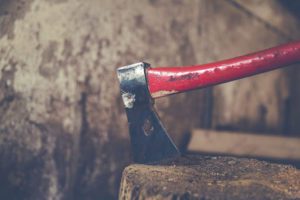
Splitting wood goes best with the right axe.
Even if you buy split wood, you may want to split it further down to make adequate kindling for your needs. Here are some tips on how to split firewood.
Splitting wood is the general process of breaking a log into smaller pieces by using a maul, which is a tool with a heavy head and a longer handle than a traditional ax. You can also use a sledgehammer and splitting wedge.
To prepare for splitting, place the log on a stump or other large piece of wood, with the piece on its end, and position yourself such that with your arms extended straight, the blade will hit the wood right in the center.
To swing and split, grip the maul like a baseball bat, then slide your hands apart so that your right hand is up near the head. Swing the maul straight back over your head with your arms apart and as you swing it forward, bring your upper arm down the handle to meet your lower arm. Repeat as necessary until the log is split, trying to hit the same place every time, and use manual separating near the end.
Tips For Storing Firewood In Maine
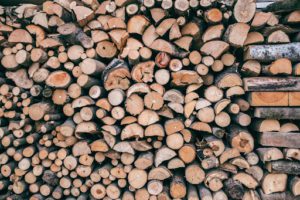
Storing your firewood so it stays dry is essential for having successful fires.
Firewood storage is an important aspect of ensuring that the wood burns hot and efficiently while also preventing the spread of pests and decay. The right way to store wood is off the ground, in a dry, ventilated area, and away from the home.
When stacking firewood outdoors, it’s important to ensure that the logs are not in direct contact with the ground, as this can lead to mold, mildew, and decay. Instead, stack the logs on wooden beams or pallets, or invest in a wood stacker designed specifically for this purpose. Additionally, it’s important to cover the woodpile to keep the logs from reabsorbing moisture. You should stack wood loosely, with an adequate amount of airflow around the woodpile, and limit the height of the pile to around 4 feet and prevent it from getting wet from rain and snow with a tarp overhead.
Alternatively, storing already-seasoned firewood in a wood shed is a common practice that helps to shelter the wood from moisture and avoid the problems of stacking wood on the ground. However, wood in a shed, unless that shed is specifically designed for drying wood, will not result in seasoning the wood, as this requires significant airflow. This is why so many choose to stack their wood outside with good airflow and a tarp overhead to avoid rain and dew moistening the wood.
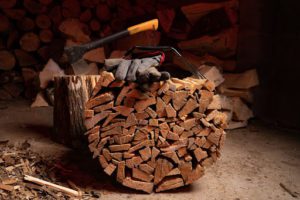
A good firewood carrier makes heating with fire much easier.
It’s also important to store firewood away from the home, as logs stacked against the home can invite pests like termites to make a home against the foundation. To avoid this, stack wood at least 20 feet away from your home and retrieve firewood in loads when you’re ready to burn it. A wood carrier is ideal for this.
In summary…
- Proper firewood storage requires the firewood to be off the ground and either protect dry wood from the elements with an enclosure or facilitate drying green wood with good airflow and some protection from rain and snow.
- Wood sheds are great for storing kiln-dried or seasoned firewood.
- It’s important to store green and seasoned firewood away from your home.
- Retrieve your firewood in small loads when you’re ready to burn it to avoid leaving potentially infested or moldy firewood in your living space.
How To Start Fires Safely With Your Maine Firewood
Starting a fire, whether in a fireplace or out in the wilderness, can be a satisfying and rewarding experience. However, it is important to follow proper safety guidelines and techniques to ensure a successful and safe fire.
To Start A Fire In A Fireplace
First, clear away any ashes from previous fires using a fireplace shovel. Make sure the flue or damper is open, and place two large, dry, split logs parallel to each other in the fireplace. Create a nest of twisted newspaper in between the logs, and place small kindling on top of the newspaper. Be sure to leave space between the pieces of wood for ventilation. If you are having trouble with downdraft, ignite a piece of newspaper and hold it up to the flue opening. This is called “priming the flue” and will help reverse the direction of the chimney’s draft. Ignite the newspaper nest in multiple spots and add new logs as needed, positioning them perpendicular to the existing logs.
To Build A Campfire
First, gather tinder and kindling materials such as dried bark, twigs, and small branches. Make sure to select a safe location for your campfire, away from any flammable materials and clear of overhanging branches. Dig a shallow pit and surround it with stones or bricks if available. Create a small teepee shape with your tinder and kindling materials in the center of the pit, and light it with a match or lighter. As the fire grows, add larger pieces of wood, being sure to keep them in a teepee shape for proper airflow. Keep a bucket of water and a shovel nearby in case of emergencies.
Wherever you’re starting a fire, it is important to use seasoned or kiln-dry firewood. Never use gasoline or other combustible liquids, as this can be dangerous, especially indoors. Always be sure to follow local regulations and guidelines for building fires, and never leave a fire unattended. By following these tips and guidelines, you will be able to safely and successfully start and maintain a fire, whether in a fireplace or out in the wilderness.
Types Of Campfires
Starting a campfire is an essential skill for any outdoor enthusiast. Whether you’re camping, backpacking, or just enjoying a backyard fire pit, a campfire can provide warmth, light, and a sense of community. However, building a campfire requires knowledge and planning to ensure that it burns safely and efficiently. In this guide, we’ll explore several different types of campfires that you can use in different situations.
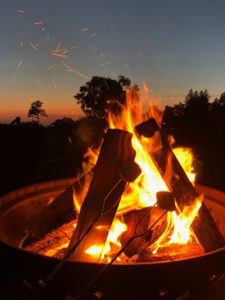
Tipi fires are great for firepits, too!
The Tipi Fire
The tipi fire is a basic fire that is easy to light and can be scaled to suit different needs. To build a tipi fire, lean your wood together to shape it into a tipi shape, leaving plenty of room for air and your matches. You can start with small kindling and tinder and then add larger logs as the fire burns. The tipi fire is perfect when you need even heating and quick lighting.
The Lean-To Fire
When in windy or damp conditions, the lean-to fire is an excellent option. To build a lean-to fire, start by building a windbreak out of a few of your larger sticks and logs. Set up your mini tipi on the leeward side of the windbreak. Then, lay longer sticks out above your core fire, stacked on the windbreak. This will allow your small starter fire to breathe without getting blown out. The lean-to fire is suitable for cooking as the windbreak is a heat reflector.
The Star Fire
The star fire is an excellent option for a fire that will burn through the night with minimal maintenance. To build a star fire, start with a mini-tipi fire and then insert larger split logs in a five-point star shape. The fire will burn outward, and all you have to do to keep it burning is slowly feed in more logs. This is a good option for a campsite or backyard fire pit.
The Log Cabin Fire
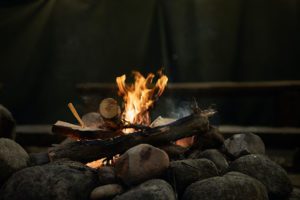
Log cabin campfires are iconic.
The log cabin fire is an excellent option for creating a bed of hot coals for cooking. To build a log cabin fire, start with a kindling tipi and then stack larger logs on either side, alternating like a Lincoln Logs kit. When lit from the bottom up, it will create an excellent bed of hot coals for cooking. Alternatively, you can build it like more of a pyramid, stacking the largest logs on the bottom and then building your core tipi at the very top. This fire will slowly and evenly burn down the pyramid.
It is important to ensure that your campfire is safe! Always check for fire bans and fire restrictions before starting a fire, and make sure that you have a source of water or a shovel nearby to put out the fire if necessary. Never leave a fire unattended, and ensure it is fully extinguished before leaving. Please refer to the earlier section on “Keeping Maine Campfires Safe” for more specific information.

Cookfires are a great tool but must be kept safe.
Building A Campfire In The Rain
To build a fire in the rain, you need extra patience, a prepared location, the right tinder, painstakingly gathered combustible materials, and a flame source such as a lighter. Here are some general tips to help you get your forest started in the rain.
- To establish a dry working area, find an area overhung by tree branches or a rocky outcropping
- If you have a tarp, rig it up to cover as large an area as possible
- If you have a tent, store and work with your wood, twigs, and tinder inside of it
- Create a windbreak to protect your fragile fire from gusts and block sideways rain
- Collect as much tinder as you can, particularly from evergreen trees
- Don’t just find dry wood; make it by splitting sticks and small logs
- Consider using the lean-to campfire type described in the previous section of this blog, as it’s good for damp conditions
- Start small, and slowly work your way up to a decent fire; when you have a strong fire, you can use less dry wood
Your greatest asset (aside from having some fatwood on hand to cheat with) is patience. If you follow these tips and remain diligent, you can light a cheery campfire in surprisingly poor conditions.
The History Of Logging In Maine: The Roots of Maine Firewood
Maine has a rich logging history that dates back to the early 17th century when English explorers first cut down trees on Monhegan Island. The state’s first official sawmill was built in 1634 in the small town of South Berwick. By the late 17th century, Maine had 24 fully operational sawmills that primarily shipped softwood, mainly pine, due to its ease of transportation during spring floods.
During this early period of logging, England’s demand for the best lumber to build masts for their naval ships played a significant role. The British Crown claimed all pines measuring 24 inches or more in diameter, at least 12 inches above the ground, under the Act of 1729. This caused resentment among the colonists, who relied on lumbering as a source of income, as they could not use these marked trees for their settlements.
The tree marking became one of the major grievances against England during the American Revolution. In 1762, a large amount of the lumber that was felled to supply England with ship masts received damage during the log drives or was deemed unsuitable for masts for various reasons and was discarded. However, 14 years later, the American colonies declared their independence from England, ending the obligatory mast lumber trade.
Post Colonial Timbering
Between 1820 and 1880, logging in New England was done in one of three ways: independent, family-operated, or through a partnership. Logging cooperatives became common the same year that Maine received its statehood, 1820. This era is known as the era of cooperation, led primarily by lumbermen associations. However, the ordinary logger didn’t profit much from his incredibly difficult and dangerous labors, as the majority of profits from the lumber industry filled the pockets of lumber barons and company owners across New England.
During the winter months, Maine’s woods were filled with logging camps. Axes, and later saws, were used to harvest various trees for specific purposes. Pine and oak were used for shipbuilding, cedar was used for shingles, hemlock for tanning, and spruce and fir were used for pulp to make paper. Logs were transported via rivers, with spring log drives being the most efficient due to the high water levels that prevented log jams and snags.
The Gradual Modernization of Timber
Gradually, the logging industry became industrialized and modernized, with more mechanized logging becoming prevalent in the middle of the 20th century. These days there aren’t any loggers using handsaws or axes to log trees in Maine, with the prevalence of mechanized tools such as chainsaws and larger machinery that can quickly cut down and strip tree trunks of their branches.
Today’s Maine logger is likely a self-employed, independent wood harvester or a small family-owned business like Day Logging, which is contracted by landowners, harvests, and then markets their timber to various buyers or processes it into firewood for sale to residents and businesses. Technology allows today’s loggers to be more productive, catering to the markets for wood products such as paper, bio-mass, structural lumber, and firewood.
Maine Firewood is an essential part of the state’s logging industry that is still in demand today. As the state has a rich history of logging, the firewood industry is also strong. With new technologies and equipment, the process of harvesting and delivering firewood has become more efficient. Today, firewood is used for both residential and commercial use, for heating homes and businesses, and for recreational activities such as camping and outdoor cooking.
Day Logging Is Here For All Your Maine Firewood Needs
At Day Logging, we proudly offer green, seasoned, and kiln-dried firewood. We’re happy to supply our local Maine and New Hampshire communities with top quality, dry firewood to keep their homes and businesses warm, as well as offering firewood bundles through various local vendors more suited to campers’ needs. If you have any questions or want to schedule a firewood delivery, please don’t hesitate to contact us today!
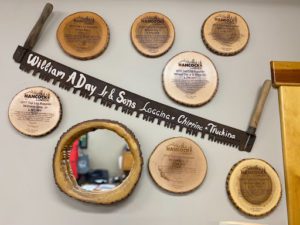
Day Logging is an award winning logging company and firewood provider based in Porter, Maine.
